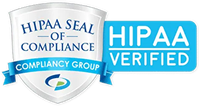Email plays a crucial role in healthcare, facilitating communication among doctors, patients, and office staff. It makes tasks such as sending test results or scheduling appointments more efficient and straightforward. However, using non-secure email services can pose significant security threats, as patients’ personal health information may be exposed due to potential security breaches.
To prevent this, the Health Insurance Portability and Accountability Act (HIPAA) requires healthcare providers to store personal health information (PHI) securely and privately. Healthcare organizations must adhere to strict guidelines to protect this sensitive data, making HIPAA essential for maintaining patient trust.
If you’re looking for HIPAA-compliant email services, it’s essential to understand what makes an email service compliant, the key features to look for, and how to choose the best option for your needs and budget.
HIPAA Compliance and Email
According to the US Department of Health and Human Services, healthcare providers can “communicate electronically, such as through e-mail, with their patients, provided they apply reasonable safeguards when doing so.”
Additionally, they clarify that “Patients may initiate communications with a provider using e-mail. If this situation occurs, the health care provider can assume (unless the patient has explicitly stated otherwise) that e-mail communications are acceptable to the individual. If the provider feels the patient may not be aware of the possible risks of using unencrypted e-mail, or has concerns about potential liability, the provider can alert the patient of those risks, and let the patient decide whether to continue e-mail communications.”
As a healthcare provider, you must ensure HIPAA compliance and use email solutions that encrypt messages and attachments sent to patients.
Consequences of Violating HIPAA
The consequences of violating HIPAA largely depend on the nature and severity of the violation. The Office for Civil Rights (OCR) often seeks to resolve issues through non-punitive approaches. These include encouraging voluntary compliance or providing technical assistance to help organizations address areas of noncompliance. However, financial penalties may be imposed when violations are severe, ongoing, or involve multiple breaches.
HIPAA penalties are structured into four distinct tiers, each based on the level of awareness and the steps taken to prevent or address the violation:
- Tier 1 applies when a covered entity was unaware of the violation and could not have reasonably prevented it, even with due diligence.
- Tier 2 involves situations where the entity should have been aware of the violation but could still not avoid it despite exercising reasonable care. This does not rise to the level of willful neglect.
- Tier 3 is for violations that result from willful neglect of HIPAA Rules, but where the organization has made efforts to correct the issue.
- Tier 4 is the most serious, applying to violations caused by willful neglect, where there is no attempt to address or correct the issue within 30 days.
HIPAA Violation Penalty Structure
Each type of HIPAA violation carries its range of potential financial penalties, which are determined by the Office for Civil Rights (OCR). When assessing a penalty, OCR considers several factors, including the duration of the unaddressed violation, the number of individuals affected, and the sensitivity of the data involved. The organization’s cooperation during the investigation also influences the outcome. Other considerations include any previous violations, the entity’s financial standing, and the extent of harm caused.
Here is the breakdown of penalties by tier:
- Tier 1: Minimum fine of $100 per violation, up to $50,000
- Tier 2: Minimum fine of $1,000 per violation, up to $50,000
- Tier 3: Minimum fine of $10,000 per violation, up to $50,000
- Tier 4: Minimum fine of $50,000 per violation, with an annual maximum of $1,500,000
The Essentials of HIPAA-Compliant Email
While you can use a HIPAA-compliant email service like MailHippo, the following steps ensure that your emails are HIPAA-compliant:
Regulatory Adherence
The National Institute of Standards and Technology (NIST) recommends that healthcare settings incorporate security measures into their electronic information practices using Advanced Encryption Standard (AES) 128, 192, or 256-bit encryption and OpenPGP and S/MIME.
If you communicate with patients with protected health information (PHI), you must ensure that the messages and attachments sent in transit and at rest are fully encrypted.
BAAs
A Business Associate Agreement (BAA) is essential to HIPAA compliance.
It’s an agreement between a HIPAA-covered entity and a third-party vendor that handles protected health information on behalf of the covered entity. This third-party vendor can be an email provider, law firm, or record keeper. The BAA agreement outlines the responsibilities for protecting PHI and ensuring secure communication, storage, and reporting during a security breach.
The business associate agreement must include the following:
- Permissible uses and disclosures related to PHI.
- Security implementation guidelines for the protection of PHI.
- Reporting process in the event of a data breach or unauthorized disclosure.
- Procedure for monitoring and auditing HIPAA compliance.
- Deletion rules for PHI on contract termination.
- Clause about third-party or subcontractor’s HIPAA compliance.
Policies and Procedures
If you’re a HIPAA-covered entity, you must follow the policies and procedures to ensure full compliance. These policies cover different scenarios to protect a patient’s health information. The following are the most important policies you must follow to maintain HIPAA compliance:
- HIPAA Privacy Rule: The privacy rule includes the necessary procedures to protect a patient’s medical records or health information from being released by non-covered entities. This policy covers all forms of communication and prevents unauthorized access to the information.
- HIPAA Security Rule: The HIPAA Security Rule outlines the essential steps to protect patients’ health information. This includes administrative, physical, and technical guidelines to maintain information integrity and secure transmission.
- HIPAA Breach Notification Rule: This rule includes notifying the affected parties, the U.S. Department of Health and Human Services, and the media in case of a security breach affecting more than 500 people.
Training Regarding HIPAA Compliance
Training plays an essential role in maintaining HIPAA compliance for email communications. To ensure effective compliance, you can adopt the following:
- Create a HIPAA email compliance plan and share it during onboarding.
- Organize HIPAA training workshops regularly to train employees who handle PHI.
- Document best practices for maintaining privacy in email communication that involves Protected Health Information (PHI).
Audits and Monitoring
In addition to encrypting email and following the policies, you must regularly audit and monitor access controls to maintain HIPAA compliance. Here are some audit and monitoring steps you can take to ensure compliance:
- Implement two-factor authentication to restrict unauthorized access to accounts that handle PHI.
- Maintain an audit control to track and log email activities for email accounts that handle patient information.
- Monitor unauthorized access or breaches in real time.
Things You Should Look for When Selecting a HIPAA-Compliant Email Solution
Encrypted email solutions can be challenging to set up and require additional steps whenever sending an encrypted email. As a result, selecting an easy-to-use option that works seamlessly with your existing email services requires minimal training for staff members who handle patients’ health information.
Before signing up with an email provider, you should check the following to ensure your email communications are HIPAA-compliant:
- HIPAA Compliance: Ensure the company is HIPAA compliant. Additionally, check if the company focuses specifically on the healthcare industry.
- Usability/Integration: You’re likely using third-party platforms to maintain your practice. As a result, check how easily the service can be integrated into existing platforms.
- Encryption System: Verify if the service automatically encrypts emails or if encryption needs to be done manually.
- Pricing Structure: Check how the company prices its services and the features included in its plans.
- Customer Service: What support options are available if customers need help?
Here at MailHippo®, we’ve designed our platform with simplicity and these factors in mind, requiring no unique configuration or setup. Imagine discussing a patient’s test results or scheduling a follow-up appointment. With MailHippo®, you can send and receive encrypted emails quickly and easily, ensuring that PHI remains secure.
Read More: Best HIPAA-Compliant Email Providers in 2025
Frequently Asked Questions about HIPAA Compliant Email:
What is HIPAA?
The Health Insurance Portability and Accountability Act (HIPAA) is a federal law that establishes national standards for safeguarding certain types of health information, specifically protected health information (PHI).
HIPAA consists of two primary rules: the Privacy Rule and the Security Rule. The Privacy Rule establishes guidelines for the use and disclosure of PHI while also granting individuals specific rights regarding their health information.
The Security Rule focuses on electronic protected health information (ePHI) and outlines the administrative, physical, and technical security measures that covered entities must implement to protect that data from unauthorized access, alteration, or loss.
What is protected health information (PHI)?
Any information that can be used to identify a patient and is used or disclosed during the course of treatment is considered PHI.
Who does HIPAA apply to?
HIPAA applies to healthcare providers, health plans, and healthcare clearinghouses. It also extends to business associates—organizations or individuals that carry out specific tasks or services on behalf of a covered entity involving access to protected health information (PHI).
What is a business associate agreement?
A Business Associate Agreement (BAA) is a legally binding contract between a covered entity and a business associate, ensuring HIPAA compliance. It outlines each party’s responsibilities and obligations when handling protected health information (PHI). Any third-party service, such as an email platform that may access PHI, must have a signed BAA in place.
Why do I need a HIPAA-Compliant Email?
If your medical practice shares patient information through email, HIPAA strongly advises using a secure, third-party email provider that qualifies as a Business Associate. Failing to do so could result in serious legal consequences if protected health information (PHI) is disclosed without the patient’s consent. Services similar to MailHippo® help ensure compliance by securing sensitive data and safeguarding patient privacy. This not only supports HIPAA adherence but also builds trust with your patients.
Can I use any email provider?
Not all email service providers are HIPAA compliant and may require additional configurations. The majority of the standard platforms do not provide encryption or security measures to protect patient files. If you’re looking for a hassle-free setup, you can get started with a free 30-day trial of MailHippo® to send and receive encrypted emails quickly and easily.
Do I need patient authorization to send PHI by email?
HIPAA permits healthcare providers to email patients about their health and treatment, provided safeguards are in place to protect PHI. Providers often obtain patient consent or document preferences regarding email communication during onboarding alongside the Notice of Privacy Practices. However, explicit patient authorization is required before sending PHI via email for communications outside of standard care, such as marketing or psychotherapy notes.
Does a disclaimer make an email HIPAA compliant?
No, a disclaimer alone does not make an email HIPAA-compliant. While a disclaimer may notify recipients of potential risks, it does not ensure the required safeguards for protecting PHI. To comply with HIPAA, healthcare providers must use secure methods for sending emails containing PHI and implement appropriate safeguards, such as encryption, to protect the information. A Business Associate Agreement (BAA) is also required with any third-party email service provider that handles Protected Health Information (PHI).
What should you do if you violate HIPAA in an email?
If you violate HIPAA in an email, the first step is to immediately report the breach to your organization’s HIPAA compliance officer or designated privacy officer. The incident should be thoroughly documented, including details of the violation, the data affected, and the individuals involved. You should then take corrective action, such as notifying the affected patients if necessary, and implement measures to prevent future breaches, including reviewing email security practices or enhancing existing safeguards. Depending on the severity of the violation, legal and regulatory steps may be necessary, including reporting the breach to the Department of Health and Human Services (HHS) if it involves a significant risk to patient privacy.



